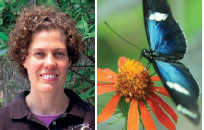Growing an urban rainforest
CALS alumna tends a rainforest in the heart of San Francisco
Kristen Natoli '91 spends her workdays in the rainforest among orchids, geckos, and lush foliage. But when she heads home on her bike, she pedals through the decidedly less tropical climate of San Francisco. Natoli, a horticulturalist, is responsible for nurturing the exotic butterflies and greenery that fill the world's largest rainforest dome, a four-story habitat at the California Academy of Sciences. Iridescent butterflies flit through the warm, moist air above a 100,000-gallon tank teeming with reptiles and amphibians; finches and tanagers perch on Theobroma cacao trees rising beneath the ninety-foot dome.

Located in Golden Gate Park, the academy comprises a planetarium, a natural history museum, an aquarium, and a colony of African penguins. Even its roof, an undulating surface dotted with round skylights and carpeted in native plants, is accessible to visitors. Thanks in large part to the rainforest exhibit, the academy has attracted some two million people since its opening in September 2008; officials expect it to be the most popular museum in San Francisco this year.
Natoli began working there in 2007, when the landscaping was still being designed. U.S. Department of Agriculture regulations had required that the seven twenty-five-foot trees from Florida—including a mahogany, a Brazilian beautyleaf, and two water chestnuts—be quarantined for a year before they could move into their new home; they arrived around the time she did. "I've spent so much energy sweating over them, staring at them, and wishing them well," she says. "You uproot an established tree and move it to a new place, it's going to take a few years to recover, but ours are doing well."
 Visitors start their tour on the ground level, which showcases the plants and insects of the Amazon rainforest. They can study the amphibians and aquatic life visible along the surface of a massive fish tank, part of the aquarium located a floor below. They then ascend a ramp that rings the exhibit, gradually rising through the habitats of Borneo, Madagascar, and Costa Rica. Along the way, leaf-cutter ants tote shards of foliage, bats cluster, and shimmering butterflies occasionally alight on a delighted child. "In an exhibit with animals and plants, most people aren't going to be looking at the plants," Natoli concedes. "Which is fine. But if we're going to talk about protecting the rainforest ecosystem, clearly the plants are the food, the housing, the defense— everything the animals can't exist without. We try to draw attention to the way all the living components of the rainforest impact and benefit each other."
Visitors start their tour on the ground level, which showcases the plants and insects of the Amazon rainforest. They can study the amphibians and aquatic life visible along the surface of a massive fish tank, part of the aquarium located a floor below. They then ascend a ramp that rings the exhibit, gradually rising through the habitats of Borneo, Madagascar, and Costa Rica. Along the way, leaf-cutter ants tote shards of foliage, bats cluster, and shimmering butterflies occasionally alight on a delighted child. "In an exhibit with animals and plants, most people aren't going to be looking at the plants," Natoli concedes. "Which is fine. But if we're going to talk about protecting the rainforest ecosystem, clearly the plants are the food, the housing, the defense— everything the animals can't exist without. We try to draw attention to the way all the living components of the rainforest impact and benefit each other."
A native of the Boston area, Natoli entered Cornell as a prevet student, but a summer job at a nursery on Long Island piqued her interest in horticulture and plant science. She settled in San Francisco after graduation and gained experience through a variety of agricultural research and greenhouse jobs—a boon to her current work, since keeping the rainforest thriving demands ingenuity. For example, Natoli eschews traditional fertilizer because its runoff will contaminate the aquarium, and slow-release pellets might be eaten by the birds. Compost and organic mulch are her fertilizers of choice. "We have to think about the animals every step of the way," she says.
Natoli was a quick study on the care and feeding of butterflies during her previous job at San Francisco's Conservatory of Flowers; she now oversees the rainforest's thirty varieties, including the iridescent blue Morpho and the green Malachite. The academy imports its pupae from cooperative farms in Costa Rica that emphasize sustainable harvesting. They're kept in temperature-and humidity-controlled chambers until they hatch; Natoli then documents them and gently releases them into the rainforest. "The process of going from caterpillar to butterfly is outrageous," she says. "If the slightest thing goes wrong, the butterfly isn't going to make it. The pupal case needs to split at just the right seam. They need to flip out and hang upside down at just the right angle. The fact that they make it at all is pretty miraculous."
Visitors to the rainforest exhibit don't always see Natoli at work. She starts at 6:30 a.m. so she can complete tasks such as watering before the academy's 10 a.m. opening. "When you work with plants, you have to work on their schedule," she says. "There are very few things I dislike about the career I've chosen. Getting up early is one of them." When guests do spot her on the job, they often pepper her with questions. Many want to know if she's upset when birds prey on the butterflies. Not at all, she reassures them. "They're usually picking off the older ones," she says. "Otherwise I have to pick them up all over the place."
— June Bell '87


